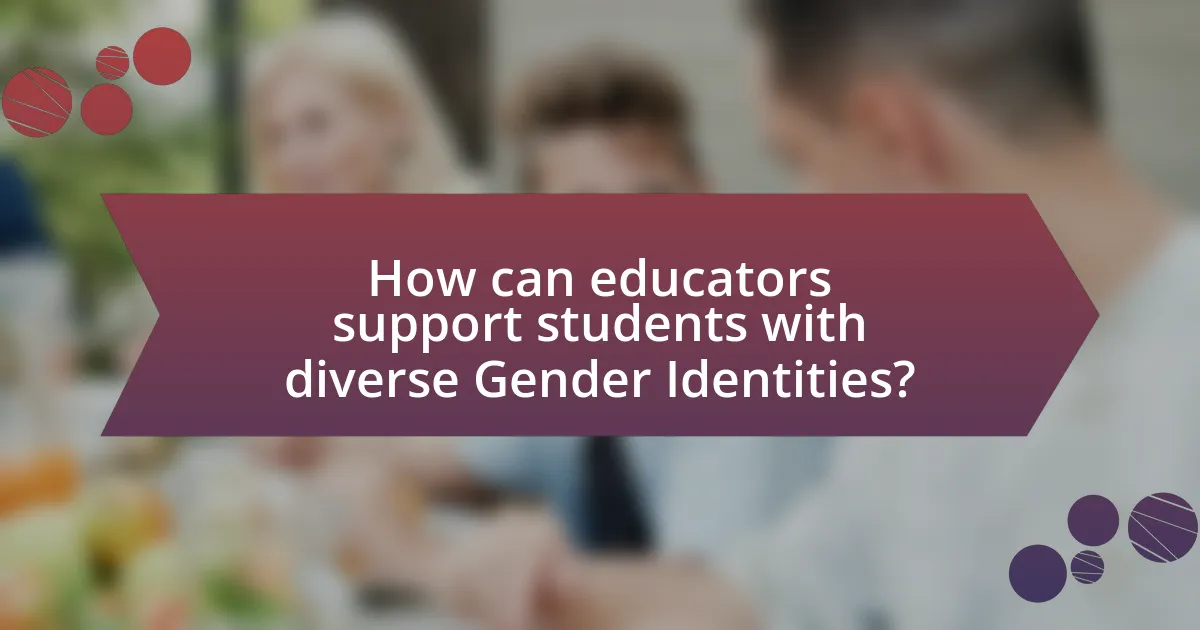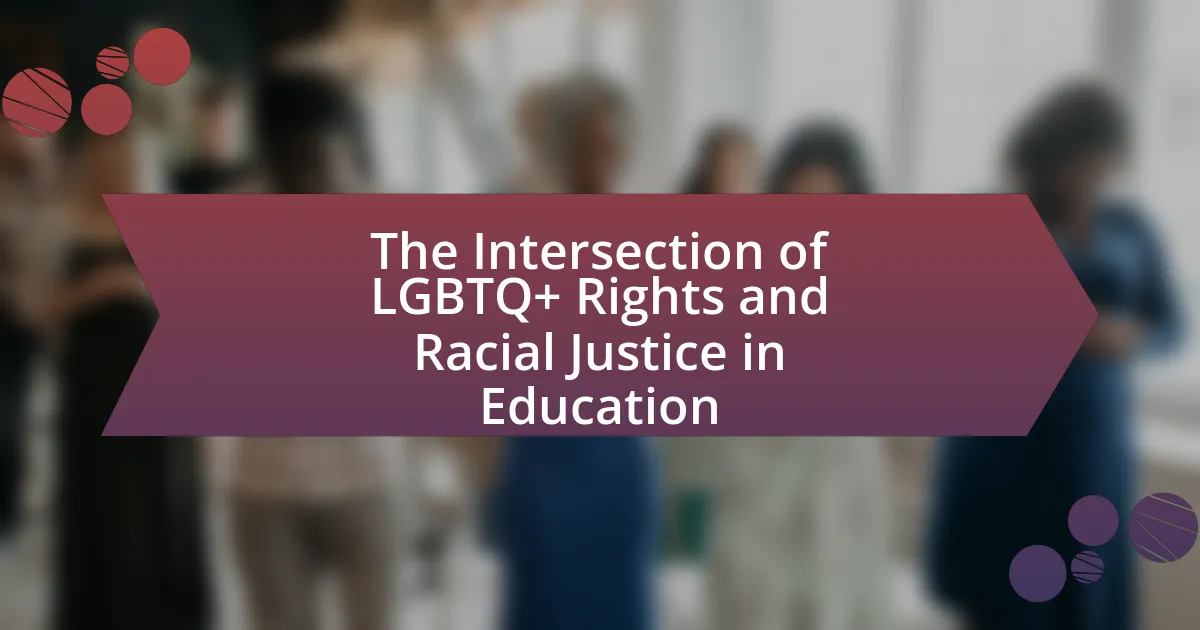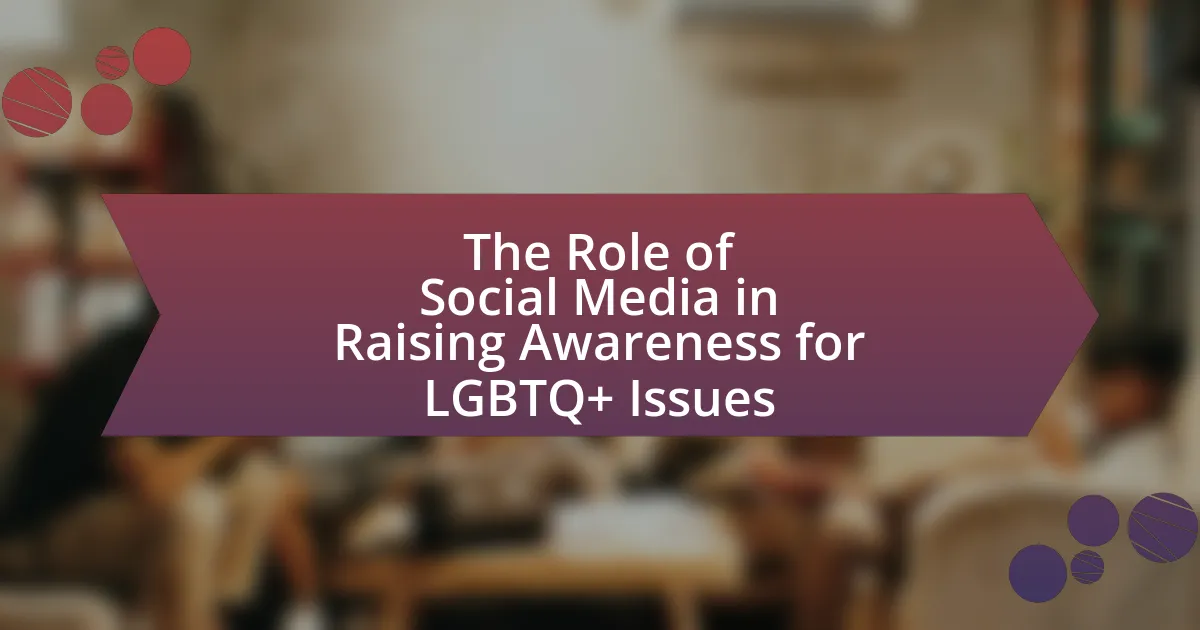Understanding gender identity is essential for educators as it encompasses an individual’s personal sense of their gender, which may differ from the sex assigned at birth. This article provides a comprehensive overview of gender identity, including its definition, key components, and the distinction between gender identity and biological sex. It emphasizes the importance of recognizing diverse gender identities in educational settings, highlighting the impact on student well-being and the necessity for inclusive practices. Additionally, the article outlines strategies for educators to create supportive environments, address bullying, and incorporate gender diversity into the curriculum, ultimately fostering a culture of acceptance and respect for all students.

What is Gender Identity?
Gender identity is an individual’s personal sense of their own gender, which may correspond with or differ from the sex assigned at birth. This concept encompasses a range of identities, including male, female, both, neither, or anywhere along the gender spectrum. Research indicates that gender identity is a deeply ingrained aspect of a person’s identity, often established in early childhood, and can be influenced by biological, social, and cultural factors. According to the American Psychological Association, understanding gender identity is crucial for fostering inclusive environments, particularly in educational settings, as it affects individuals’ mental health and well-being.
How is Gender Identity defined in contemporary society?
Gender identity in contemporary society is defined as an individual’s personal sense of their own gender, which may or may not align with the sex assigned at birth. This understanding acknowledges that gender is not strictly binary and encompasses a spectrum of identities, including male, female, transgender, non-binary, and genderqueer. Research indicates that societal recognition of diverse gender identities has increased, with studies showing that approximately 1.2 million adults in the United States identify as transgender, reflecting a growing awareness and acceptance of gender diversity. This evolving definition emphasizes the importance of self-identification and the social, cultural, and personal factors that influence one’s gender experience.
What are the key components of Gender Identity?
The key components of gender identity include personal identification, expression, and societal roles. Personal identification refers to an individual’s internal sense of their gender, which may align with or differ from their assigned sex at birth. Expression encompasses how individuals present their gender through clothing, behavior, and communication. Societal roles involve the expectations and norms associated with different genders, which can influence how individuals experience and express their gender identity. These components are supported by research indicating that gender identity is a complex interplay of biological, psychological, and social factors, as highlighted in studies such as “The Gender Identity Development Scale” by Dr. R. C. McGuire et al.
How does Gender Identity differ from biological sex?
Gender identity refers to an individual’s personal sense of their gender, which may or may not align with the sex assigned to them at birth. Biological sex is determined by physical attributes such as chromosomes, hormone levels, and reproductive/sexual anatomy. For example, a person assigned female at birth may identify as male, non-binary, or another gender, illustrating the distinction between their biological sex and their gender identity. This differentiation is supported by research from the American Psychological Association, which emphasizes that gender identity is a complex interplay of biological, social, and individual factors, highlighting that it is not strictly tied to biological sex.
Why is understanding Gender Identity important for educators?
Understanding gender identity is crucial for educators because it fosters an inclusive and supportive learning environment for all students. Educators who comprehend gender identity can better address the diverse needs of their students, promoting mental well-being and academic success. Research indicates that students who feel accepted regarding their gender identity are less likely to experience bullying and mental health issues, leading to improved educational outcomes. For instance, a study published in the Journal of School Psychology found that inclusive practices significantly reduce instances of harassment and increase overall student engagement. Thus, understanding gender identity equips educators to create a safe space that respects and values each student’s identity.
What impact does Gender Identity have on student well-being?
Gender identity significantly impacts student well-being by influencing their mental health, social interactions, and academic performance. Students who identify with a gender different from their assigned sex at birth often experience higher levels of anxiety, depression, and bullying, which can detrimentally affect their overall well-being. Research from the National School Climate Survey indicates that LGBTQ+ students face increased victimization and discrimination, leading to lower self-esteem and higher dropout rates. Furthermore, supportive environments that affirm students’ gender identities correlate with improved mental health outcomes and academic success, highlighting the importance of inclusive practices in educational settings.
How can educators create an inclusive environment for all gender identities?
Educators can create an inclusive environment for all gender identities by implementing policies and practices that respect and affirm diverse gender expressions. This includes using inclusive language, such as gender-neutral pronouns, and providing training for staff on gender identity issues to foster understanding and support. Research indicates that schools with inclusive policies report higher levels of student well-being and engagement, as seen in the 2019 GLSEN National School Climate Survey, which found that LGBTQ+ students in supportive environments experience less harassment and greater academic success. By actively promoting acceptance and understanding, educators can significantly enhance the educational experience for all students, regardless of their gender identity.

What are the different types of Gender Identities?
There are several types of gender identities, including male, female, transgender, non-binary, genderqueer, genderfluid, agender, and bigender. Male and female are traditionally recognized as the binary genders, while transgender refers to individuals whose gender identity differs from the sex assigned at birth. Non-binary encompasses those who do not identify strictly as male or female, and genderqueer is often used interchangeably with non-binary. Genderfluid individuals experience shifts in their gender identity over time, while agender individuals identify as having no gender. Bigender individuals identify as two genders, either simultaneously or at different times. These classifications reflect the diverse spectrum of gender identities recognized in contemporary discussions about gender.
What are the most recognized Gender Identities today?
The most recognized gender identities today include male, female, transgender, non-binary, genderqueer, genderfluid, agender, and bigender. These identities reflect a spectrum of gender experiences beyond the traditional binary understanding. For instance, transgender individuals identify with a gender different from the one assigned at birth, while non-binary individuals do not exclusively identify as male or female. According to a 2021 report by the Williams Institute, approximately 1.2 million adults in the United States identify as transgender, highlighting the visibility and recognition of diverse gender identities in contemporary society.
How do non-binary and genderqueer identities fit into the spectrum?
Non-binary and genderqueer identities exist within the gender spectrum as valid expressions that do not conform strictly to traditional binary notions of male and female. These identities challenge the conventional understanding of gender by encompassing a range of experiences that may include elements of both genders, neither, or fluctuate between them. Research indicates that approximately 25% of LGBTQ+ youth identify as non-binary or genderqueer, highlighting the significance of these identities in contemporary discussions about gender. This inclusion reflects a broader recognition of diverse gender experiences beyond the binary framework, affirming the legitimacy and visibility of non-binary and genderqueer individuals within the spectrum of gender identity.
What is the significance of transgender identities in education?
Transgender identities are significant in education as they promote inclusivity and respect for diverse gender expressions, which is essential for creating a safe learning environment. Recognizing and affirming transgender identities helps reduce bullying and discrimination, leading to improved mental health outcomes for transgender students. Research indicates that inclusive educational practices, such as using correct names and pronouns, significantly enhance the academic performance and well-being of transgender individuals. For instance, a study published in the Journal of Adolescent Health found that supportive school environments correlate with lower rates of depression and suicidal ideation among transgender youth. Thus, integrating transgender identities into educational frameworks is crucial for fostering equity and supporting the overall development of all students.
How do cultural perspectives influence Gender Identity?
Cultural perspectives significantly influence gender identity by shaping the norms, values, and expectations surrounding gender roles within a society. For instance, in many Western cultures, gender identity is often viewed through a binary lens, categorizing individuals strictly as male or female based on biological sex. In contrast, cultures such as the Hijra community in South Asia recognize a third gender, illustrating that gender identity can be fluid and culturally specific. Research indicates that societal acceptance of diverse gender identities varies widely; for example, a study published in the Journal of Homosexuality found that individuals from cultures with rigid gender norms often experience higher levels of discrimination and mental health issues related to their gender identity. This evidence underscores the profound impact that cultural frameworks have on how individuals understand and express their gender identity.
What role does intersectionality play in understanding Gender Identity?
Intersectionality plays a crucial role in understanding gender identity by highlighting how various social identities, such as race, class, sexuality, and ability, intersect to shape individual experiences of gender. This framework reveals that gender identity is not experienced in isolation; rather, it is influenced by multiple, overlapping factors that can create unique challenges and privileges for individuals. For instance, a study by Crenshaw (1989) introduced the concept of intersectionality, demonstrating that Black women face discrimination that is distinct from that experienced by white women or Black men, thus emphasizing the need for a nuanced understanding of gender identity that considers these intersecting identities. This approach allows educators to better support diverse students by recognizing the complexities of their identities and the systemic inequalities they may face.
How can educators respect diverse cultural views on Gender Identity?
Educators can respect diverse cultural views on gender identity by actively engaging in cultural competency training and fostering an inclusive environment. This approach allows educators to understand and appreciate the varying beliefs and practices related to gender identity across different cultures. Research indicates that culturally responsive teaching improves student engagement and academic success, as it acknowledges and values students’ backgrounds (Gay, 2010). By incorporating diverse perspectives into the curriculum and encouraging open dialogue, educators can create a safe space for all students to express their identities while respecting cultural differences.

How can educators support students with diverse Gender Identities?
Educators can support students with diverse gender identities by creating an inclusive environment that respects and affirms each student’s identity. This can be achieved through implementing policies that allow for the use of preferred names and pronouns, which research shows significantly improves the mental health and well-being of transgender and non-binary students. For instance, a study published in the Journal of Adolescent Health found that students who felt supported in their gender identity reported lower levels of depression and anxiety. Additionally, educators should incorporate gender diversity into the curriculum, providing representation and fostering discussions that normalize diverse identities. Training staff on gender inclusivity and establishing clear anti-bullying policies further reinforces a safe space for all students.
What strategies can educators implement to foster inclusivity?
Educators can implement strategies such as creating a safe and supportive classroom environment, incorporating diverse perspectives in the curriculum, and using inclusive language to foster inclusivity. A safe environment encourages open dialogue and respect among students, which is essential for discussing sensitive topics like gender identity. Incorporating diverse perspectives ensures that all students see themselves represented in the curriculum, promoting a sense of belonging. Using inclusive language, such as gender-neutral terms, helps to validate all students’ identities and experiences. Research indicates that inclusive practices in education lead to improved academic outcomes and social-emotional well-being for all students, as highlighted in the study “The Impact of Inclusive Education on Student Outcomes” by the National Center for Learning Disabilities.
How can educators address bullying related to Gender Identity?
Educators can address bullying related to gender identity by implementing comprehensive anti-bullying policies that specifically include protections for gender identity. These policies should be communicated clearly to students, staff, and parents, ensuring that everyone understands the consequences of bullying and the importance of respect for all identities. Research indicates that schools with inclusive policies see a significant reduction in bullying incidents; for example, a study by the Gay, Lesbian & Straight Education Network (GLSEN) found that schools with comprehensive anti-bullying policies reported lower levels of harassment based on gender identity. Additionally, educators should provide training on gender diversity to staff and students, fostering an environment of understanding and acceptance. This approach not only addresses bullying but also promotes a culture of inclusivity and respect within the school community.
What resources are available for educators to learn about Gender Identity?
Educators can access various resources to learn about Gender Identity, including online courses, professional development workshops, and educational organizations. For instance, the Human Rights Campaign offers a comprehensive guide titled “Supporting and Caring for Transgender Children,” which provides insights and best practices for educators. Additionally, the National Education Association has resources focused on LGBTQ+ inclusivity in schools, including lesson plans and policy recommendations. Research from the American Psychological Association highlights the importance of understanding gender identity in educational settings, emphasizing that informed educators can create supportive environments for all students.
What are best practices for discussing Gender Identity in the classroom?
Best practices for discussing gender identity in the classroom include creating an inclusive environment, using correct pronouns, and providing accurate information. Educators should establish ground rules that promote respect and openness, ensuring that all students feel safe to express their identities. Using correct pronouns is essential, as research shows that affirming a student’s gender identity can significantly improve their mental health and academic performance. Additionally, incorporating comprehensive and age-appropriate educational materials about gender identity helps dispel myths and fosters understanding among students. Studies indicate that inclusive curricula can lead to a more supportive school climate, benefiting all students.
How can educators facilitate open conversations about Gender Identity?
Educators can facilitate open conversations about gender identity by creating a safe and inclusive environment where students feel comfortable expressing themselves. This involves establishing ground rules for respectful dialogue, actively listening to students’ experiences, and providing accurate information about gender diversity. Research indicates that inclusive curricula and discussions can significantly reduce stigma and promote understanding among peers, as shown in studies like “The Impact of Inclusive Education on Gender Identity Awareness” published in the Journal of Educational Psychology. By integrating diverse perspectives and encouraging questions, educators can foster a culture of acceptance and support for all students.
What role does curriculum play in educating about Gender Identity?
Curriculum plays a crucial role in educating about gender identity by providing structured content that fosters understanding and acceptance. It serves as a framework for educators to introduce concepts related to gender diversity, helping students to explore and understand their own identities and those of others. Research indicates that inclusive curricula can significantly reduce bullying and discrimination, as seen in studies like the 2019 GLSEN National School Climate Survey, which found that LGBTQ+ students in schools with inclusive curricula reported feeling safer and more supported. Thus, a well-designed curriculum not only informs but also promotes a respectful and inclusive environment for all students.
What practical tips can educators use to support Gender Identity awareness?
Educators can support gender identity awareness by implementing inclusive curricula that reflect diverse gender identities and experiences. This can be achieved by integrating literature, history, and social studies that highlight contributions from various gender identities, fostering a more comprehensive understanding among students. Additionally, educators should create a safe and supportive classroom environment by using inclusive language, respecting students’ chosen names and pronouns, and addressing any instances of bullying or discrimination promptly. Research indicates that inclusive educational practices can significantly improve the well-being and academic performance of LGBTQ+ students (GLSEN, 2019). By actively promoting awareness and understanding of gender identity, educators contribute to a more equitable and respectful learning environment.





